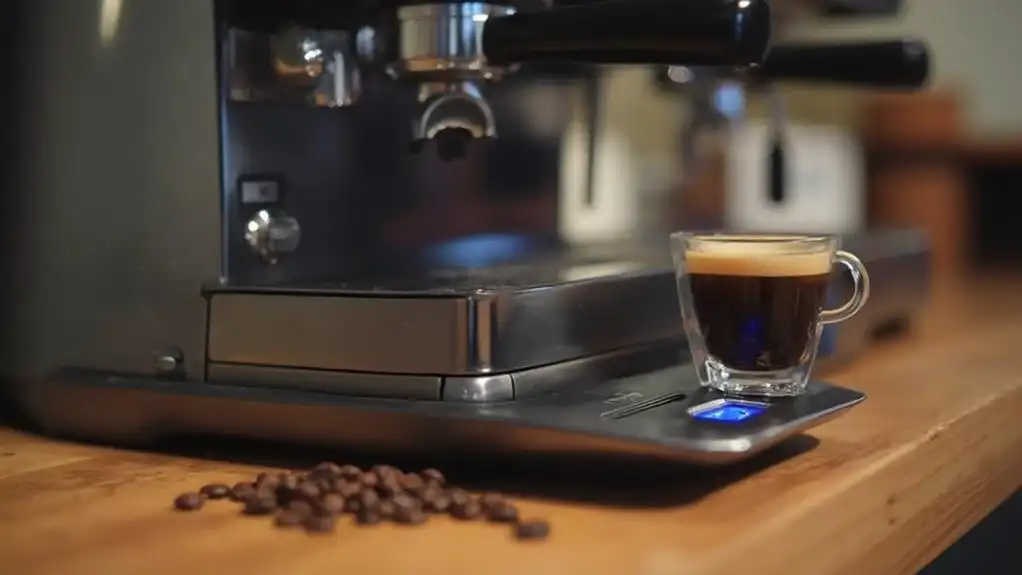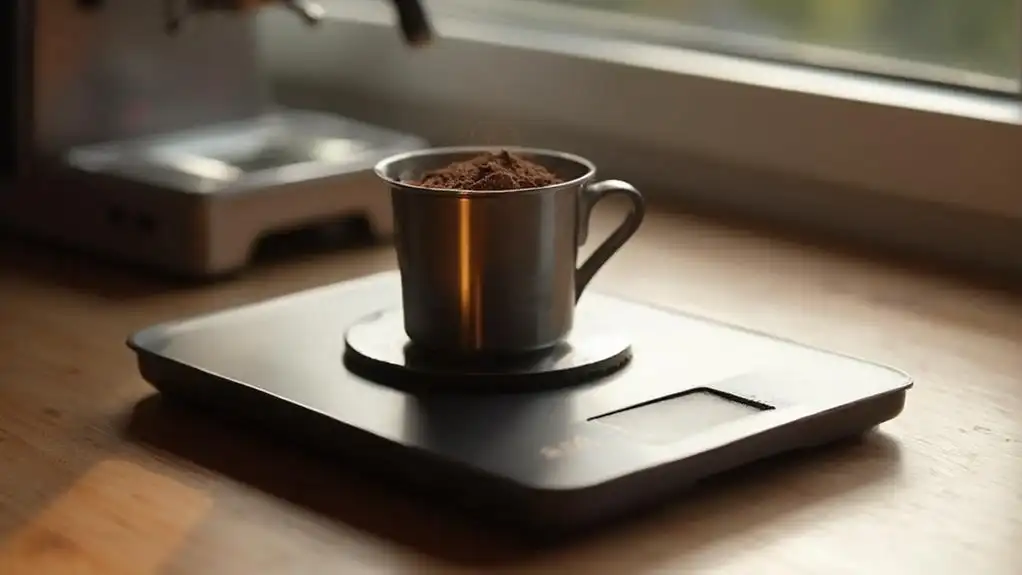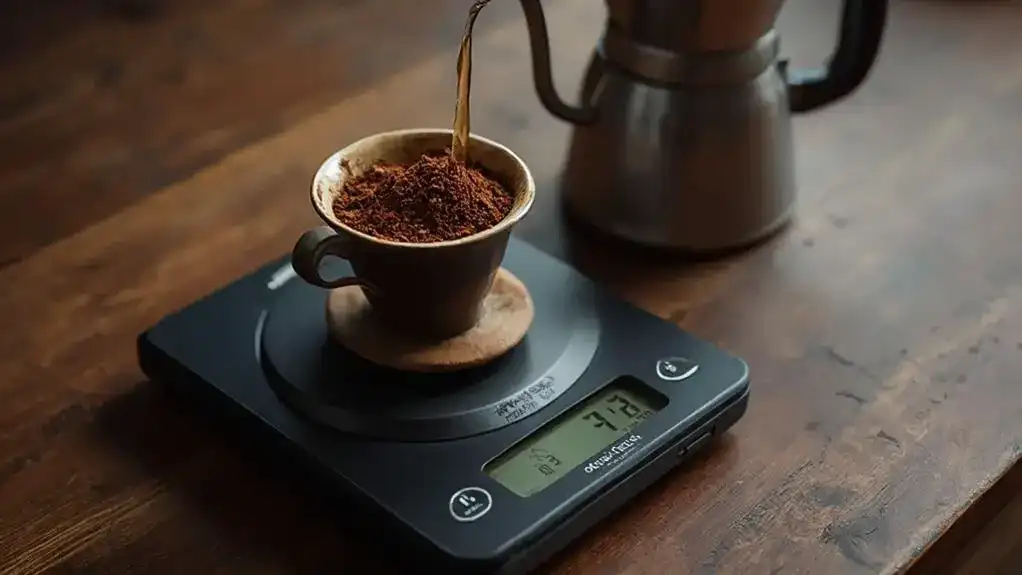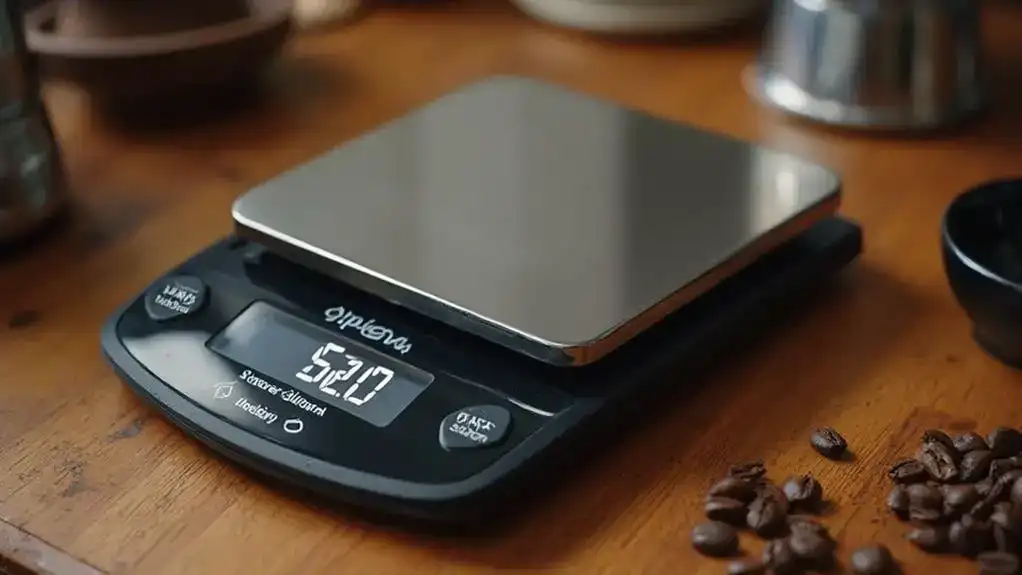Using coffee scales for espresso involves several precise steps to guarantee excellent results. First, choose a digital scale with at least 0.1-gram accuracy. Place the scale on a stable surface and calibrate it. Measure 18-20 grams of coffee, using the tare function with an empty portafilter for accuracy. For water, aim for a 1:2 coffee-to-espresso ratio. Monitor extraction time, targeting 25-30 seconds for peak flavor. Consistency is key, so document your measurements and adjust variables like grind size to improve taste. By refining your technique, you can elevate your espresso brewing experience considerably. More tips await your exploration.
Why use coffee scales for espresso?

Using coffee scales for espresso helps you achieve precision in your brewing process. By measuring coffee and water in grams, you enhance your espresso precision and guarantee brewing accuracy.
A scale allows you to replicate successful shots, as even slight variations can lead to significant differences in flavor and extraction. The ideal coffee dose, typically around 18 grams for a single shot, is critical; weighing your coffee prevents guesswork.
Additionally, tracking extraction time with the scale guarantees you achieve the best 25-30 seconds for full flavor development. This methodical approach elevates your espresso-making experience, allowing for adjustments based on taste preferences, and fosters an innovative mindset in your brewing routine.
Investing in a good scale is essential for any serious espresso enthusiast.
How do you choose the right scale for espresso?
When it comes to selecting a scale for espresso, precision and ease of use are key factors. You want a scale that can deliver reliable measurements, ensuring your brewing precision.
Here are three essential criteria to take into account:
- Scale Accuracy: Look for scales that measure in grams with at least 0.1-gram precision. This level of accuracy is vital for achieving consistent espresso shots.
- User-Friendly Design: Opt for a scale with an intuitive interface and easy-to-read display, making your brewing process seamless.
- Timer Functionality: A scale with a built-in timer allows you to track extraction times accurately, enhancing your brewing precision.
How do you set up your coffee scale for espresso?

To set up your coffee scale for espresso, start by placing it on a flat, stable surface near your espresso machine. This guarantees accuracy during your espresso setup.
Next, check for scale calibration; an accurate measurement is essential for extracting the best flavors. Turn on the scale and select the grams mode, which is standard for espresso brewing.
If your scale has a tare function, utilize it by placing an empty portafilter or cup on it and resetting the weight to zero. This way, you’ll only measure the coffee or espresso weight without any extras.
What is the best surface for your coffee scale?
Choosing the right surface for your coffee scale is essential for accurate measurements and successful espresso brewing.
To guarantee scale stability, place your scale on a flat, solid surface that can absorb vibrations and resist movement. Surfaces like a countertop or kitchen table made from wood or stone work best, as they provide a sturdy foundation.
Avoid using uneven or soft materials, like rubber mats or cloth, which can distort readings. Additionally, consider the height of the surface; it should be comfortable for you to work with while allowing easy visibility of the scale’s display.
How do you measure coffee and water for espresso?

When measuring coffee for espresso, you should aim for about 18-20 grams for a single shot, ensuring precision with a scale that reads in grams.
To weigh water, use the same scale, aiming for a brew ratio of approximately 1:2, which means for every gram of coffee, you should aim for about 2 grams of liquid.
This careful measurement helps maintain consistency and enhances the quality of your espresso shots.
How do you measure coffee for espresso?
When measuring coffee for espresso, you typically aim for 18-20 grams for a single shot and 18-22 grams for a double shot.
This precise dosing is essential for achieving a balanced flavor profile and ideal extraction.
Additionally, weighing the water used in the process can help maintain consistency across your espresso shots, ensuring each brew meets your expectations.
How do you measure coffee dose for single and double shots?
Measuring the coffee dose for single and double espresso shots is essential for achieving the perfect extraction. For single shots, aim for 17-18 grams, while for double shots, target 18-22 grams. Proper coffee dosing guarantees espresso accuracy, enhancing flavor profile and consistency.
| Shot Type | Coffee Dose (grams) | Brew Ratio |
|---|---|---|
| Single | 17-18 | 1:2 |
| Double | 18-22 | 1:2 |
How do you weigh water for espresso?
When weighing water for espresso, understanding coffee-to-water ratios is essential.
Typically, a ratio of 1:2 is recommended, meaning for every gram of coffee, you should aim for about 2 grams of water.
This balance guarantees ideal extraction and flavor, so measuring both components accurately with your scale can greatly enhance your espresso brewing consistency.
What are the coffee-to-water ratios for espresso?
Achieving the perfect coffee-to-water ratio is essential for pulling a great shot of espresso. Common espresso ratios include 1:2, where you use 18 grams of coffee to yield 36 grams of espresso. Experiment with different ratios to discover your preferred taste.
| Coffee (grams) | Water (grams) |
|---|---|
| 18 | 36 |
| 20 | 40 |
| 22 | 44 |
How do you use the coffee scale for espresso?
To use a coffee scale for espresso, start by dosing your coffee accurately, typically between 17 and 20 grams depending on your shot size.
As you begin the extraction process, place your cup on the scale to monitor the weight of the espresso as it brews, ensuring you achieve your desired yield.
How do you dose espresso using scales?
Dosing espresso accurately is essential for brewing the perfect shot, and using a coffee scale makes this process simple and precise.
Start by selecting a scale that measures in grams with at least 0.1-gram accuracy, which is crucial for effective espresso dosing techniques.
Place your empty portafilter on the scale and tare it to zero. Measure approximately 17-18 grams for a single shot, ensuring coffee weight accuracy.
Grind the coffee to a fine consistency, then check the weight again. The goal is to achieve consistency in your measurements, as slight variations can greatly impact flavor and extraction.
How do you start the espresso extraction process with the scale?
After weighing and preparing your coffee, you’re ready to start the espresso extraction process.
First, place your espresso cup on the scale and tare it to zero. This guarantees you’re only measuring the weight of the espresso as it flows into the cup.
Next, activate your espresso machine to begin the extraction. As the espresso starts pouring, watch the scale closely to track the weight.
Aiming for a brew ratio of about 1:2, adjust your extraction time to around 25-30 seconds. This precision in monitoring weight during espresso extraction is essential for perfecting your brewing techniques, allowing you to produce consistently flavorful shots.
How do you use a timer with coffee scales for espresso?
using a timer in conjunction with your coffee scale is essential for achieving the perfect espresso shot.
To start, incorporate timer techniques by utilizing the built-in timer on your scale or a separate stopwatch. Begin the timer as you activate your espresso machine, tracking extraction timing closely. Ideally, your shot should complete within 25-30 seconds for ideal flavor.
As the espresso extracts, monitor the weight on the scale, ensuring you reach your desired yield, typically a 1:2 brew ratio. Stopping the timer and extraction simultaneously allows for precise measurement, enhancing consistency in your brews.
How can you achieve consistency in espresso?

To achieve consistency in your espresso, you need to focus on precise measurements and careful adjustments.
Start by using your scale to measure coffee and water accurately each time, which helps replicate flavor profiles.
Additionally, practice tweaking variables like grind size and extraction time based on your tasting notes to enhance your results.
How do you achieve consistent espresso shots with scales?
Achieving consistent espresso shots requires careful attention to detail from the moment you start brewing.
To begin, focus on precise espresso calibration by weighing your coffee dose, typically around 18-20 grams for a single shot. Next, maintain consistent brewing ratios, ideally a 1:2 ratio of coffee to liquid espresso. This guarantees balanced extraction and flavor.
Use a scale to monitor both coffee and water weights, adjusting as necessary for your taste preferences. Regularly calibrate your scale to confirm accuracy, as even slight discrepancies can affect your shot.
How can you practice consistency in measurements?
When brewing espresso, consistency in measurements is key to perfecting your shots. To establish reliable consistency practices, start by using precise measurement techniques, ensuring you weigh both coffee and water each time.
Utilize a scale that measures in grams, with a minimum precision of 0.1 grams. Taring your scale before each measurement prevents weight discrepancies.
Keep a detailed log of your measurements, noting the coffee dose, water weight, and extraction time. This record allows you to replicate successful brews.
Additionally, experiment with different coffee-to-water ratios while maintaining accurate weights. By focusing on these consistent methods, you’ll refine your brewing process, leading to improved espresso quality and flavor with each shot.
How do you adjust variables for flavor improvement?
Adjusting variables can lead to significant flavor improvements in your espresso. To achieve the perfect flavor profile, focus on three key variables:
- Grind Size: A finer grind can increase extraction time and enhance flavors, while a coarser grind may lead to under-extraction and a sour taste.
- Coffee Dose: Experiment with different coffee doses; increasing the amount can intensify flavors, while decreasing it may lighten the profile.
- Extraction Time: Aim for a 25-30 second extraction. Shortening this time can bring out brightness, while extending it may enhance body and richness.
How do you maintain and care for your coffee scale?
To keep your coffee scale in top condition, it’s important to clean it regularly after each use.
Start by gently wiping the surface with a soft, damp cloth to remove any coffee grounds or spills. Avoid using harsh chemicals that can damage the scale’s finish.
For effective scale maintenance, make certain that moisture doesn’t seep into any openings, as this can affect performance. If your scale has removable parts, like a bowl, wash those separately with mild soap.
Regularly calibrate your scale to maintain accuracy, which is vital for espresso brewing.
What scale features are important for espresso?

When selecting a scale for espresso, you should consider several key features that enhance your brewing experience.
Here are three important points to think about:
- Digital vs. Analog: Digital scales offer precise measurements and often include timers, while analog scales may lack accuracy but can be more durable.
- Portability: A lightweight and compact scale is easier to store and transport, making it ideal for travel or small kitchens.
- Multi-functionality: Some scales can also be used for other brewing methods, which adds versatility to your coffee-making toolkit.
What is the difference between digital and analog coffee scales?
Digital and analog coffee scales each come with their own unique features that cater to different brewing preferences.
Digital scales provide precise measurements, often down to 0.1 grams, allowing for accurate dosing, which is essential for espresso. They usually include built-in timers, enabling you to track extraction times seamlessly.
In contrast, analog scales rely on a dial for measurement, offering a tactile experience but typically lack the precision digital scales provide. They can be less expensive and don’t require batteries, appealing to those who prefer simplicity.
Ultimately, when choosing between digital and analog scales, consider the importance of accuracy, convenience, and your personal brewing style to enhance your espresso experience.
Can you use coffee scales for other brewing methods?
While coffee scales are essential for brewing espresso, they can also be used for various other methods, such as pour-over, French press, and cold brew.
Their scale versatility makes them invaluable for achieving consistency across different brewing techniques. Here are three key features to take into account for alternative brewing:
- Precision: Just like with espresso, accuracy in measuring coffee and water is vital for other methods to enhance flavor profiles.
- Timer Functionality: Monitoring extraction times can greatly influence the taste, regardless of the brewing method used.
- Weight Capacity: Confirm the scale can handle various weights, especially for larger batches when brewing methods like French press.
Incorporating these features allows you to innovate and refine your coffee experience across all brewing styles.
How can you enhance your espresso brewing experience?
Enhancing your espresso brewing experience can be as simple as focusing on the details that matter most.
To achieve brewing precision, start by honing your espresso techniques. Invest in a high-quality coffee scale, which allows for accurate measurements of coffee and water. Experiment with different grind sizes and brewing ratios to discover what yields the best flavor for your palate.
Keep a log of your sessions, noting adjustments in weight and extraction time, to refine your process consistently. Don’t overlook the importance of water temperature and quality, as they greatly influence extraction.
Conclusion
Mastering the use of coffee scales for espresso is akin to fine-tuning a musical instrument; precision leads to harmony in flavor. By selecting the right scale, measuring accurately, and maintaining consistency, you’ll compose an espresso that resonates with rich flavors. Each shot becomes a note in your brewing symphony, echoing the science behind extraction and ratios. As you refine your technique, you’ll discover the joy of creating a perfect cup, elevating your coffee experience to new heights.

